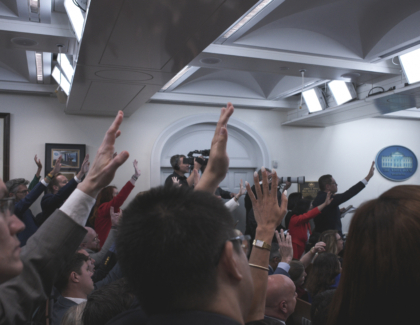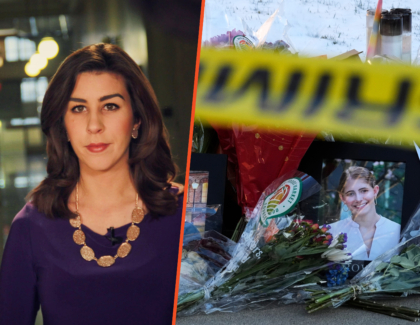Sign up for the daily CJR newsletter.
On a Sunday in early February, Lilian Tahan, executive director of the Brazilian news website Metrópoles received a call from the morning editor. News was coming out that Sabrina Bittencourt—the activist behind the recent downfall of famous faith healer João Teixeira de Faria, also known as “John of God,” over sexual assault charges—had committed suicide. The editor was eager for the story.
At first, Tahan wasn’t sure. There had been a previous fake report of Bittencourt’s death. But this time, Bittencourt’s oldest son and a well-known colleague, the president of an NGO, confirmed that she had died. Before midday, virtually every outlet in the country, including Metrópoles, had run the story. (The international press mostly avoided it, bar a few tabloid reports.)
When Tahan shared the Metrópoles article on a WhatsApp group discussion with sources in the capital, Brasília, there was a consensus among political figures and analysts: Bittencourt had succumbed to the pressure of a prominent role in Brazil’s first major #MeToo scandal. She was a sexual assault survivor herself, and the founder of a movement dedicated to reporting instances of abuse by religious leaders, and had gathered hundreds of testimonies from victims against Faria. She often fed information to journalists. And her face was featured on the cover of a national magazine as the woman who had brought down “John of God.” Death threats had followed.
But as the country mourned the activist’s death and celebrities posted promises, on social media, to carry on her legacy, the precise circumstances around Bittencourt’s suicide remained mysterious. Had she taken her own life in Spain, according to initial reports, or in Lebanon, as her son later declared? Was there a death certificate?

Sabrina Bittencourt, via Facebook.
Journalists tried contacting the embassy in Beirut and the Ministry of Foreign Affairs, but there was no official record of a Brazilian woman’s death in the first days of February. Reporters with Folha de S. Paulo, the main daily newspaper in Brazil, went to the small town of Indaiatuba, in the state of São Paulo, to interview Bittencourt’s family, but the only story they got centered on how her mother and sisters were warding off attention. Soon, another theory surfaced: Bittencourt was not dead, but living in hiding outside the country under a different identity.
Metrópoles enlisted Cleuci de Oliveira, a freelance journalist, to investigate. “We weren’t the first to become suspicious that the outcome wasn’t the official version,” Tahan said, noting that established publications had already flagged inconsistencies in the story. “But in the end, everyone had published information that was wrong, so there was a tacit, unspoken discomfort.”
Oliveira first learned about Bittencourt while working on a story on how social media helps disseminate fake news about international trafficking of children. In January, the activist–with a scarf around her head and a light on her face–, appeared in a six-minute video accusing ”John of God” of running a two-decade-long human trafficking operation that sold babies to families in the US, Australia, and European countries for up to $50,000. (Public prosecutors later opened an investigation based on Bittencourt’s accounts.)
“The video looked to me like a horror movie—very “The Handmaid’s Tale”–like,” Oliveira says. “When you work for a long time as a journalist, you can tell when things don’t seem to make a lot of sense.”
When the news of the suicide came out, Oliveira decided to partner with David Ágape, an architecture student who started running an independent fact-checking website. Ágape had published what he calls a dossier on Bittencourt’s life: a compilation of declarations and public appearances the activist made over the years, including a highly publicized episode in which she said she had lost all memory of 11 years of her life. Bittencourt had accused Ágape, in a list shared with journalists, of threatening her. He says the allegations against him have no merit; they were Bittencourt’s way of responding to growing suspicion around the veracity of her stories.
“Anyone asking questions was being attacked by her supporters on the internet,” Ágape says.
Two months later, Oliveira and Ágape published a stirring profile, built on evidence from 50 sources, of Bittencourt in Metrópoles. Most people close to the activist, according to the article, don’t believe the story of suicide.
Bittencourt’s first husband said he suspects she is with their son in an unknown location. Other family members, speaking anonymously, provided evidence of unsuccessful attempts to obtain reliable information about Bittencourt’s death. (In a series of statements discrediting the article in the comments section, a user identified as Bittencourt’s son recently said the family doesn’t owe the press explanations and that the concerned authorities in the case have evidence that his mother is dead.)
Bruna de Lara, a reporter with The Intercept covering human rights and gender issues, was one of the first to criticize the media coverage of the case. In “The Hunting of Sabrina Bittencourt’s Body,” published in February, she argued that publications failed to weigh the value of the story against the safety concerns. “If her death is real, the lack of respect for the family’s pain is insensitive, to say the least,” Lara wrote. “If it is not, working to prove that this woman has forged her death so she can stay alive is to put her head back in a guillotine.”
In the weeks leading up to the news of Bittencourt’s suicide, Lara had a video call with the activist. She said Bittencourt used to email and text her, as well as other journalists and public defenders, with updates on the accusations involving ‘John of God’ and general comments about the threats against her, without ever disclosing her location. “My initial impression was that I had never seen someone so exhausted,” Lara says. “She sounded like someone crying for help and her voice and manners matched the situation she was describing.”
Following the publication of the Metrópoles piece, Lara hasn’t changed her mind about the media’s initial approach to the story. “People’s lives are worth more than the news,” she says. “My impression was that clicks were worth more than her life.” But she also conceded that Oliveira and Ágape’s investigation, developed over a longer period of time, was well-supported and responsible, even if it didn’t provide a definitive answer either way.
In the absence of irrefutable evidence, Tahan says that is what she was aiming for. “We needed to do exhaustive reporting to get to the point where the readers could say: ‘She’s alive,'” Tahan says, adding: “She’s going to appear and we need to keep following.”
Has America ever needed a media defender more than now? Help us by joining CJR today.







